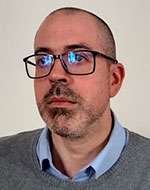Monday (24 May 2021)
15:00-17:00 – Tutoial 1: Malware Analysis and Detection
Presented by Ashu Sharma and Hemant Rathore
Abstract: Often computer/mobile users call everything that disturbs/corrupts their system a VIRUS without being aware of what it means or accomplishes. This tutorial systematically introduces the different malware varieties, their distinctive properties, different methods of analyzing the malware, and their detection techniques
Speakers’ Biographies
Ashu Sharma is currently working as a senior malware analyst at WatchGuard, India. He has more than three years of industrial experience in malware analysis and more than two years of teaching experience. He has completed his Ph.D. in static malware analysis from BITS Pilani, India, and post-doctoral in malware identification via dynamic analysis under Prof. Sandeep Shukla (IIT Kanpur, India). He was the speaker at many reputed conferences/workshops and had many publications in reputed conferences/journals.
Hemant Rathore is currently working as Assistant Professor at the Department of CS and IS at BITS Pilani, Goa Campus, India. Before joining academics, he was working in the area of computer security for three years at Symantec, India. His Ph.D. is on the topic of Adversarial Robustness and Explainability in Malware Detection Models. His research interests are in the area of Malware Analysis, Network Security, Machine Learning, and Operating Systems. He has guided several undergraduate and postgraduate students in their independent research projects and published many research papers in reputed journals/conferences.
Friday (28 May 2021)
15:00-17:00 – Tutorial 2: What Will Wi-Fi 7 Be?
Presented by Lorenzo Galati-Giordano, Giovanni Geraci, and Boris Bellalta
Abstract: As hordes of data-hungry devices challenge its current capabilities, Wi-Fi strikes again with802.11be, alias Wi-Fi 7. This brand-new amendment promises a (r)evolution of unlicensed wireless connectivity as we know it, unlocking access to gigabit, reliable and low-latency communications, and reinventing manufacturing and social interaction through digital augmentation. More than that, time sensitive networking protocols are being put forth with the overarching goal of making wireless the new wired. With its standardization process being consolidated, we will provide an updated digest of 802.11be essential features, place the spotlight on some of the must-haves for critical and delay-sensitive applications, and illustrate their benefits through standard-compliant simulations.
Speakers’ Biographies
 Lorenzo Galati-Giordano (SM’20) is Senior Research Scientist at Nokia Bell Labs since 2015. His current focus is on next generation Wi-Fi technologies, an area where he is contributing with pioneering works on large antenna arrays solutions for the unlicensed spectrum. He has more than 10 years of academical and industrial research experience, co-authored 20+ commercial patents, 30+ publications in prestigious books, IEEE journals and conferences, and 9 standard contributions in the IEEE 802.11be.
Lorenzo Galati-Giordano (SM’20) is Senior Research Scientist at Nokia Bell Labs since 2015. His current focus is on next generation Wi-Fi technologies, an area where he is contributing with pioneering works on large antenna arrays solutions for the unlicensed spectrum. He has more than 10 years of academical and industrial research experience, co-authored 20+ commercial patents, 30+ publications in prestigious books, IEEE journals and conferences, and 9 standard contributions in the IEEE 802.11be.
 Giovanni Geraci (SM’19) is an Assistant Professor at University Pompeu Fabra. He was previously with Nokia Bell Labs and holds a Ph.D. from UNSW Sydney. He serves as an IEEE ComSoc Distinguished Lecturer, as an Editor for the IEEE TWC and IEEE COMML, and as the IEEE ICC’22 Wireless Comms Symposium co-Chair. He has delivered more than ten IEEE ComSoc tutorials and workshop keynotes and he received the IEEE ComSoc Outstanding Young Researcher Award for Europe, Middle-East, and Africa
Giovanni Geraci (SM’19) is an Assistant Professor at University Pompeu Fabra. He was previously with Nokia Bell Labs and holds a Ph.D. from UNSW Sydney. He serves as an IEEE ComSoc Distinguished Lecturer, as an Editor for the IEEE TWC and IEEE COMML, and as the IEEE ICC’22 Wireless Comms Symposium co-Chair. He has delivered more than ten IEEE ComSoc tutorials and workshop keynotes and he received the IEEE ComSoc Outstanding Young Researcher Award for Europe, Middle-East, and Africa
 Boris Bellalta (SM’13) is an Associate Professor at Universitat Pompeu Fabra (UPF), where he heads the Wireless Networking group. His research interests are in the area of wireless networks and performance evaluation, with emphasis on Wi-Fi technologies, machine learning, and resource management. His recent works on multiuser communication, spatial reuse and spectrum aggregation for IEEE 802.11ax have received special attention from the research community and industry.
Boris Bellalta (SM’13) is an Associate Professor at Universitat Pompeu Fabra (UPF), where he heads the Wireless Networking group. His research interests are in the area of wireless networks and performance evaluation, with emphasis on Wi-Fi technologies, machine learning, and resource management. His recent works on multiuser communication, spatial reuse and spectrum aggregation for IEEE 802.11ax have received special attention from the research community and industry.
17:00-19:00 – Tutorial 3: Challenges and Solutions for Flight Duration Enhancement in UAV Wireless Networks
Presented by Mustafa A. Kishk, Member, IEEE, and Mohamed-Slim Alouini, Fellow, IEEE
Abstract: Drone-mounted base-stations (DBSs) have a great potential to enhance wireless coverage and data rate of IoT networks, as well as other applications such as data dissemination and collection. However, one of the main challenges in such technology is the limited on-board battery. The limited energy resources lead to a drone flight time that typically does not exceed one hour. Hence, the drone needs to frequently fly back to a charging station to replace/recharge its battery. During this time, the quality of service (QoS) experienced by the users in the coverage area of the drone might degrade. Hence, it is necessary to find innovative solutions that enable a longer drone flight time, in order to ensure a stable wireless coverage provided by the users. In this tutorial, we first discuss the general advantages and potential use cases of DBSs. Next, we discuss the limited drone battery influence on the performance of the drone-enabled wireless network. In particular, we discuss a stochastic geometry-based framework that accurately captures the influence of the battery size, the density of the charging stations, and the required charging time on the performance of the wireless network. Next, we enlist a set of potential solutions that have the potential to extend the flight time of DBSs with emphasis on: (1) tethered drones and (2) laser-powered drones. For each of the two solutions, we first briefly discuss the technology state of the art. Next, we provide a set of open research directions for these novel system architectures that require revisiting many well-established results in the literature of drone-enabled wireless networks analysis.
Speakers’ Biographies
 Mustafa A. Kishk [S’16, M’18] is a postdoctoral research fellow in the communication theory lab at King Abdullah University of Science and Technology (KAUST). He received his B.Sc. and M.Sc. degree from Cairo University in 2013 and 2015, respectively, and his Ph.D. degree from Virginia Tech in 2018. His current research interests include stochastic geometry, energy harvesting wireless networks, UAV-enabled communication systems, and satellite communications.
Mustafa A. Kishk [S’16, M’18] is a postdoctoral research fellow in the communication theory lab at King Abdullah University of Science and Technology (KAUST). He received his B.Sc. and M.Sc. degree from Cairo University in 2013 and 2015, respectively, and his Ph.D. degree from Virginia Tech in 2018. His current research interests include stochastic geometry, energy harvesting wireless networks, UAV-enabled communication systems, and satellite communications.
 Mohamed-Slim Alouini [S’94-M’98-SM’03-F’09] was born in Tunis, Tunisia. He received the Ph.D. degree in Electrical Engineering from the California Institute of Technology (Caltech), Pasadena, CA, USA, in 1998. He served as a faculty member in the University of Minnesota, Minneapolis, MN, USA, then in the Texas A&M University at Qatar, Education City, Doha, Qatar before joining King Abdullah University of Science and Technology (KAUST), Thuwal, Makkah Province, Saudi Arabia as a Professor of Electrical Engineering in 2009. His current research interests include the modeling, design, and performance analysis of wireless communication systems.
Mohamed-Slim Alouini [S’94-M’98-SM’03-F’09] was born in Tunis, Tunisia. He received the Ph.D. degree in Electrical Engineering from the California Institute of Technology (Caltech), Pasadena, CA, USA, in 1998. He served as a faculty member in the University of Minnesota, Minneapolis, MN, USA, then in the Texas A&M University at Qatar, Education City, Doha, Qatar before joining King Abdullah University of Science and Technology (KAUST), Thuwal, Makkah Province, Saudi Arabia as a Professor of Electrical Engineering in 2009. His current research interests include the modeling, design, and performance analysis of wireless communication systems.


